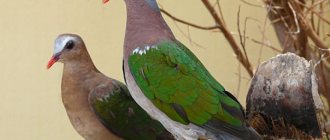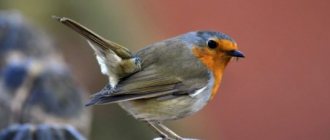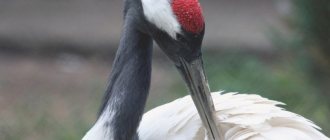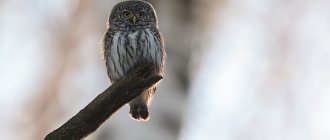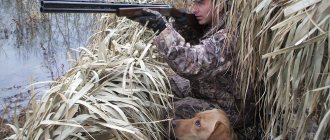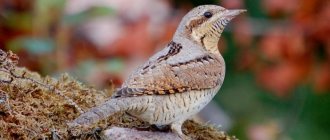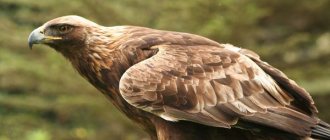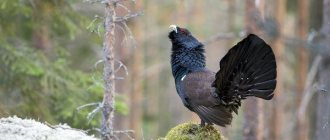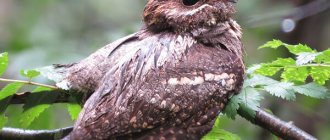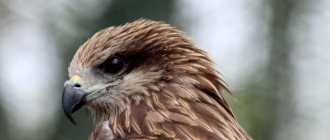Hello everyone, many of us have heard more than once in the spring the spring song of the cuckoo, supposedly counting down the years of our lives, but only a few know that the cuckoo’s cuckooing is performed not by the female, but by the male cuckoo.
His mating call serves to attract the female cuckoo to the nest and he uses it to mark his territory. I will tell you about this in my article today.
One day at the beginning of June I was conducting a summer internship with students. From the very early morning we climbed far from home and only in the afternoon, tired from the long excursion, barely moving our legs, we returned back.
One day on the way home we decided to make a short stop to rest and have breakfast. The sun rose high above the forest, but the restless birds did not stop. From time to time, the rollicking trill of a finch could be heard, and somewhere off to the side, at the top of a spruce tree, the simple song of a warbler, “Ting-ting-shadow, ting-ting-shadow,” rang loudly.
— How many of you know the legend about the chiffchaff? — I asked the students. No one knew. And I told them about one of my meetings in the remote Siberian taiga with a gold seeker who told me the legend of the warbler.
general characteristics
Cuckoos are small birds, measuring about 32-38 cm in length and weighing about 140 grams. They have a long tail, reaching half the size of their body. The wingspan of the cuckoo is at least 50 cm.
The body of cuckoos is long and thin, there are short, not very developed legs. They are colored yellow, the beak is dark and slightly curved. The structure of the paws is formed in such a way that two claws are directed forward, and the other two look back.
Birds have sexual differences that manifest themselves in appearance. Adult males have a darker color on the tail and back, while the plumage on the throat and chest is light gray. There are dark stripes on the body. Females have more red and brown shades in their plumage. Dark stripes are located across the body, and the feathers are edged with white. In the chest area the color is light. In addition, males are larger than females.
Differences between males and females of different species
Cuckoos molt twice a year. The first time this happens in the summer, the second time in the winter.
On the territory of the Russian Federation, the cuckoo can be found everywhere
This is practically true when it comes to the period from May to July. Cuckoos cannot be seen except on the northern tundra. It is interesting that in the European part of the country you can see representatives of only one species from the cuckoo family - the common cuckoo, in the central part of Russia - two species, but in the eastern part of the country there are 5 parasitic species of cuckoos. Cuckoos found on the territory of the Russian Federation prefer to settle in forests and parks. Particularly favorite places for them are coastal thickets, bushes, clearings and edges along clearings.
Where do cuckoos live in the wild?
The natural habitats of cuckoos directly depend on their species. At the same time, the habitat of birds is extremely extensive; they can be found on almost all continents, excluding Antarctica. These birds are able to live in any climate zone: from tropical to forest-tundra. Most often, cuckoos are found in Eurasia and North America. The largest population of birds, Common Cuckoos, inhabit the area from the Atlantic to the Pacific Ocean.
Common cuckoos are migratory birds that do not stay in one nesting place for more than 3-4 months per year. At the same time, they are able to cover distances of 5-6 thousand kilometers, reaching places where they will spend the winter.
For the winter, birds usually gather in Africa, India or the southern part of China. In nesting areas, cuckoos settle in deciduous forests, forest belts, and sometimes in thickets of bushes. If there are few trees around, birds can be found in open areas, provided there are free-standing bushes nearby.
Other species of cuckoos can live in India, Thailand, Singapore, the Philippines, and the African continent. In Russia, two types of cuckoos are most often found - the Common Cuckoo and the Deaf Cuckoo.
Poll: Have you ever seen a cuckoo in the wild?
Yes, I saw it
60%
No, I have not seen)
40%
Voted: 30
The Legend of the Chiffchaff
“What are you doing here?” — I asked a wizened, handsome man fiddling with a small basin on the bank of a taiga stream. He looked up at me. “I’m washing the golden sand,” he answered, without looking up from what he was doing.
“Who are you, how did you get here?” - the stranger asked in turn. “I’m kind of a bird hunter, collecting all sorts of birds for collections.”
We sat down on the bank of a stream on a fallen tree and started talking. In the taiga there is no one to exchange a word with, and you are glad when you meet even a stranger.
“You have climbed far for the birds. Aren’t they closer?” — my interlocutor grinned. “Is golden sand only found in this stream?” - I asked in turn. Instead of answering, the seeker only waved his hand.
Somewhere above us, as now, a Chiffchaff was singing. Among the giant cedars in the silence of the silent taiga, her sonorous song flowed somehow especially.
“Just don’t hurt this bird, it sings very well,” he pointed with his eyes to the top of the cedar. - Look how he pronounces his song! But I learned from water. A bird flew to a taiga spring of cold water to drink. And above the spring, water oozed from under the stone, and drop by drop dripped into the spring.
Either a fontanelle drips in the middle, or it gets stranded on the side - the sounds are different. So the chiffchaff bird learned to sing a song, as if a fontanel in the taiga was collecting sonorous drops,” my new friend finished the story.
What does a cuckoo eat in the wild?
The cuckoo is an omnivorous bird; insects make up most of its diet. However, it can also feed on plant foods such as berries, shoots, seeds or fruits. A delicacy for the cuckoo would be:
- Mosquitoes.
- Grasshoppers.
- Beetles.
- Butterflies.
- Snails.
- Slugs.
Cuckoos happily eat hairy caterpillars, which can be poisonous.
Sometimes they are able to fly small lizards and snack on the eggs of other birds. Cuckoos obtain prey by picking it up from the ground or branches; they rarely hunt on the fly.
Despite their small size, cuckoos are quite voracious and love to eat. This is due to the need to accumulate subcutaneous fat, which is used by birds when making long-distance flights during winter migration. The appetite of cuckoos decreases only at the beginning of the mating season, since all the birds' attention is aimed at finding a suitable partner.
The chicks born to cuckoos are also voracious. They gain weight very quickly and often exceed the size of the chicks of other birds.
In an hour, one adult cuckoo can eat about a hundred caterpillars. In this case, the standard rate per day is about 1500.
Cuckoos become the birds that control the insect population, which is an extremely important factor in maintaining the forest ecosystem and natural balance. They destroy pests that eat foliage, so their activity is extremely important. Contrary to popular belief, cuckoos are very useful birds, even despite nesting parasitism in relation to their offspring.
The broad-winged cuckoo has a wide distribution range
We are talking about the distribution area of individuals of this species in the Far East of the Russian Federation. The broad-winged cuckoo can be found in the south of the Khabarovsk Territory and Primorye. However, despite this circumstance, ornithologists have significantly less information about the reproductive biology of the broad-winged cuckoo, compared to other species belonging to the cuckoo family and found in Russia. Yuri Pukinsky (Primorye researcher, famous ornithologist), for example, called the broad-winged cuckoo a mystery bird, because it is extremely difficult to track this bird or find its eggs. But the voice of the wide-winged cuckoo is heard throughout the taiga. The male's voice resembles a buzzing sound that extends over time and increases in volume and tone. The female's voice resembles the male's, differs in tone (lower) and duration (short).
Lifestyle and behavioral characteristics
Most species of cuckoos are migratory birds. They usually live in Europe or southern Africa, and in winter they migrate to North Africa or the eastern part.
The cuckoo crows
Of all the cuckoo species, the most studied is the common cuckoo, which is the most common. The bird spends most of its time in dense forests and thickets, where neither man nor animal can find it. During this period, the cuckoo stops singing and tries to lead as closed a life as possible. Birds spend most of their time alone, without uniting with the flock or with their partner.
During the mating season, cuckoos become much more sociable and open. The males begin to perform mating songs, while the females search for a suitable territory in which to breed their offspring. When the female shows interest in a potential partner, he dances a mating dance: lowers his head and wings, spreads his long tail and waves it like a fan. Afterwards, the gentleman presents his lady with grass or a twig, which symbolizes consolidation of the union and gaining the favor of the female.
Mating games of cuckoos can consist of both spectacular performances and fierce fights between males and each other. Clashes between competitors are common during the mating season.
Cuckoos are predominantly diurnal and, due to the need to accumulate subcutaneous fat, are constantly searching for food. The structural features of the paws do not allow birds to descend to the ground for a long time.
If they do walk on the ground, they usually take off immediately after catching an insect or lizard. This feature of the movement of cuckoos causes the almost complete absence of traces of the bird’s paws on the ground.
Cuckoos do not build their own nests. Common cuckoos are a prime example of nesting parasites that lay eggs on other parents. They are not involved in raising and raising offspring, as a result of which other birds become the feeders of the chicks, into the nests to which they are thrown.
Elena
Ask a Question
Question to the expert
How long do cuckoos live on average?
The lifespan of birds in the wild is approximately 6-8 years. At the same time, it is known for certain about cases where, in good conditions and with sufficient food, cuckoos live about 15 years.
Social structure
The most common bird species, the Common Cuckoo, is a polygamous bird. It is not typical for these birds to form flocks, and they even form pairs for one season. However, they have romantic mating rituals in which males actively seek the attention of females. The breeding season lasts from mid-April to mid-July.
Cuckoos do not have a nesting territory like other birds. In one place there can be either one female with several males, or several females with one male.
Their habitat will be considered the place in which the cuckoo begins to look for other nests where it will lay eggs. If two females live in the same area, they will lay their eggs on birds of different species.
Cuckoos most often spend time alone
Character and habits of cuckoos
Cuckoos are distinguished by their cautious nature and secretive lifestyle. They almost never leave traces of their presence and do not come into contact with other birds. Despite the fact that these birds can sing and demonstrate their presence, they will never let people get close to them, making it extremely difficult for ornithologists to observe cuckoos. Most of the time, birds are hidden behind the dense crowns of trees: they can rarely be seen on the ground.
Cuckoos feel good during flight, which is easy and swift for them. In their mode of movement they are similar to falcons and other species belonging to the hawk family.
Cuckoos prefer not to have close contact even with their own kind. The more adult a bird becomes, the larger its nesting area. At the same time, males can cede part of their possessions to females, who require a lot of personal space. The area of ownership of one individual occupies several hectares.
Kinds
The common cuckoo is the most famous bird among its relatives, of which there are many. The cuckoo family includes 6 genera of birds:
- Pied-billed;
- spur;
- running;
- larvae eaters;
- American;
- real.
The diversity of birds is represented by 140 species of cuckoos, which differ significantly from each other. Color variations appeared as a result of birds adapting to their habitat.
Pied-billed cuckoos. Thin body, elongated tail, strong paws. They live mainly in Central and South America. Cuckoo chicks raise themselves, but they can also parasitize, laying eggs in the nests of other birds.
Spur cuckoos. The long claw of the thumb gives its name to the genus, which lives in the tropics and subtropics. The bird is the size of a crow. The color is black-brown with a greenish-blue tint. The cuckoos create their own nests; they nurse the chicks, taking turns taking care of them.
Running (ground) cuckoos. They live in the Western Hemisphere. They rarely take to the air and are often found along roads. Striped coloring, a crest on the top of the head, a long neck and tail help to maneuver while running, making sharp turns. In raising offspring, the cuckoo is a nest parasite.
Larvae eaters. A prominent representative is the Brazilian ani larvae. It is often found on the American continent near pastures, where there is always a food supply of parasitic insects. Notable is its small, powerful beak, flattened on the sides.
Cuckoo larva-eater ani
American cuckoos. They vary in size, but all have long tails, strong legs, and graceful shapes. The undertail is often painted in a black and white pattern. They build their own nests, rarely parasitizing others.
Real cuckoos. Distributed in Eurasia in spring and summer. They spend the winter in Africa. Bristly, white-headed, crested, gigantic, drong and other species belong to this large group.
The most common of them is the common cuckoo. which bird of the genus is more parasitic than others, but they all throw eggs into the nests of other birds.
Reproduction and raising of offspring
Recommended by topic
Blackbirds Woodpecker Heron
Birds fly to their nesting site in the spring, when their wintering on the African continent ends. During the mating season, cuckoos can not only pair up, but also gather in small groups. Birds choose areas for settlement in places where other species of birds actively nest.
Females do not build nests, as is the case with other birds. Their task is to study the territory and observe the behavior of the “neighbors”. Adult males, as a rule, fertilize several females at once during the season.
Over time, evolution has helped cuckoos adapt to resemble a particular species of bird in appearance. This was necessary so that the eggs that ended up in other people’s nests would be similar to the offspring of these birds, so that the “foster parents” would not suspect anything.
Females thoughtfully watch the birds in the area, studying the behavior of their “neighbors.” This helps them quickly work at a convenient moment to lay their eggs and get rid of the eggs of their real parents. When other birds return back to the nest, they do not see the replacement and continue to incubate the chicks, which hatch before their own children.
Different species of cuckoos lay different numbers of eggs. Thus, the common cuckoo can produce no more than one egg, and the crested cuckoo can produce from 2 to 4 eggs.
Regardless of the number of alien chicks hatching in the nest, newborns try to get rid of other eggs and chicks. Since cuckoo chicks are born earlier, they grow stronger and gain strength faster, due to which they can easily eliminate competitors. Thanks to this, the chicks remain the only contenders for food obtained by the “foster parents”.
Chicks can grow much larger than their “foster parents”
Cuckoo chicks grow quite quickly, and for this they require a large amount of food. Already in the third week of life, the babies grow so much that they can leave the nest on their own. Despite this, their “parents” continue to feed the chick for a month, which is capable of flying and getting food on its own.
Question to the expert
Who does the cuckoo throw eggs to?
In central Russia, cuckoos can throw eggs to various families of birds. Among them one can distinguish sparrows, nightingales, swifts, and kinglets. In Europe, nest parasitism usually affects wagtails, shrikes, warblers, and redstarts. This easy substitution is explained by the fact that birds usually have little knowledge of what their eggs look like, which is why they do not see the difference. In addition, evolutionarily, cuckoos have adapted to ensure that their eggs outwardly coincide as closely as possible with those laid by birds of certain varieties. The birds themselves can even hatch objects whose shape is similar to an egg. kinglets, nightingales, swifts, sparrows and many others.
Population
Its extensive habitat makes the common cuckoo a species whose population does not cause any concern. Europe alone is home to about two million pairs. Therefore, these birds are not protected, and no one is taking any measures to increase their numbers
Cuckoos are unpretentious, adapt well to conditions, have a fairly varied diet, and do not disdain poisonous insects - all these factors contribute to their completely calm survival. Competition between species simply does not exist for them.
The population decline occurs only in those regions where urban development is actively developing, and, accordingly, the number of trees and shrubs decreases. The birds' natural habitat is disappearing, and cuckoos are forced to develop other territories.
A sharp decrease in the number of cuckoos in Moscow and the region was the reason for their inclusion in the Red Book of the region in 2001: the species received the second category - with a decreased number. However, to date there have been no changes for the worse or for the better.
All forest areas in Moscow, in which cuckoos have been observed breeding, have received the status of a special environmental zone. Some of them were included in already existing territories with a similar status.
Due to the fact that the city is growing, and high-density multi-storey buildings are being erected on the outskirts, natural and artificially created large green areas are isolated from each other. A number of measures have been planned to improve the overall ecology of the city.
The priority is to improve living conditions not only for cuckoos, but also for small passerine birds. City parks, forest belts and green areas are under close control.
Additionally, the reconstruction of forests, which leads to a simplification of their composition and structure, is also prohibited.
Natural enemies
Adult cuckoos have very few enemies, which is due to their secrecy, agile and fast flight, as well as their external similarity to species of birds of prey. In some circumstances, cuckoos can become victims of:
- Orioles.
- Warblers.
- Sorokoputov.
- Gray flycatchers.
Bird - oriole
Usually collisions occur among chicks, which are not yet experienced and strong enough to withstand the predators attacking them.
In addition to birds of prey, mammals such as foxes, weasels, and martens also pose a danger to cuckoos. However, this problem practically does not concern agile birds, since they rarely descend to the ground and behave extremely carefully.
The danger for cuckoos lies not only in attacks on young individuals, but also in the destruction of nests where the eggs were thrown. This can be done by crows or jays, which can eat eggs and kill small chicks when foster parents cannot prevent this.
The broad-winged cuckoo egg is large in size
This is true. It exceeds the size of the eggs of all other representatives of the cuckoo family inhabiting the territory of the Russian Federation. As for the color of the shell, it is similar to the color of the eggs of the parent species of the broad-winged cuckoo - the blue nightingale. The color of the shell is bluish-green, light. Cuckoo eggs have brownish spots in common with the eggshells of another parent species, the blue flycatcher. However, in this case, the broad-winged cuckoo egg is noticeably different from the host eggs. Although this does not prevent the blue flycatcher from carefully incubating an unusual egg and feeding a chick that is not its own. The eggs of the broad-winged cuckoo have an oval-ellipsoidal shape.
Chick Survival School
The common cuckoo, whose appearance is unremarkable, nevertheless has amazing cunning. She one by one throws her eggs into different nests, and with a pure soul she goes to South Africa for the winter. Meanwhile, sad events occur in the nests of the adoptive parents.
The baby cuckoo, as a rule, hatches a couple of days earlier than its fellows. During this time, he manages to acclimatize in the nest. Although he is still blind and naked, he has already developed the throwing instinct. Imagine him throwing away everything that touches his bare back. First of all, these are eggs and chicks. The chick is in a hurry to do its job. Instinct works in him for only four days. But this is quite enough to destroy competitors. Even if someone survives, he still has little chance of survival. The fact is that the cuckoo takes away all the food that its foster parents bring.
Bird food
The common cuckoo feeds on insects.
Other cuckoos also love insects, but in addition they eat other foods:
- small lizards, snakes and rodents (plantain cuckoo);
- grasshoppers and mantises (thick-billed cuckoo);
- soft fruits of woody plants, eucalyptus seeds, eggs and chicks of small birds (giant cuckoo).
When a common cuckoo lays an egg in someone else's nest, most often it eats one of the ones already there. For her, this is an excellent source of protein, replenishing spent energy.

